|
| OO Scale | N Scale | G Scale | Z Scale | HO Scale | Slot Cars & R⁄C |
| |||||||
|
|||||||
| Home Page | |||||||
| BUY GIFT VOUCHERS | |||||||
| Products | |||||||
| Latest News | |||||||
| RIGHT LINES | |||||||
| Bargains | |||||||
| Downloads | |||||||
| Events | |||||||
| Careers & Jobs | |||||||
| Carriage Services | |||||||
| About Us | |||||||
| Contact Us | |||||||
| Pay Us A Visit | |||||||
| Meet The Staff | |||||||
| Links | |||||||
| SHOPPING BASKET |
Your shopping basket is empty. To add an item, click the "Buy" button
| YOUR ACCOUNT | ||
|
||||
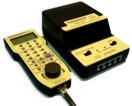 |
||||
| Prodigy Advance Digital System |
||||
| Cased Controllers |
||||
| Panel Mount Controllers |
||||
| Walkabout Controllers |
||||
| Modules & Transformers |
||||
| Scenics & Accessories |
||||
| Wiring & Electrical Components |
||||
| Tiny Signs | ||||
| Tools | ||||
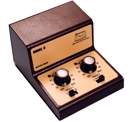 |
||||
| RECENTLY VIEWED |
| PR28136 - Couple Standing Figure | ||
| PK35261 - Weatherproof On/Off Control Box (4 Accessories) | ||
| B36-082 - Pigs (10) Figure Set | ||
| B36-081 - Cows (7) Figure Set | ||
| FA180914 - Blue Dumpsters (2) Kit | ||
| More ›› |
| O Scale | Wargaming | Architectural | Narrow Gauge | Tools+ | ||
ICE Trains

JOHN CHANDLER looks at the trains that run on the German High Speed network.
The term 'ICE' (pronounced 'Its-e') describes Germany's entry into the world of 'high speed' train travel.
Not restricted to Germany, these trains can also be found in Austria, Denmark, Belgium, France, and Switzerland. Variants even exist in Spain, Russia and China!
About a decade after the French had started development of their TGV (Train à Grande Vitesse, High Speed Train), Germany decided to jump on the bandwagon and began a series of trials in 1985 with the ICE-V test train, also known as the InterCityExperimental. On 1st May 1988, this train set a new world speed record of 406.9km/h (253mph).
Unlike France, Germany did not adopt an integrated approach from the start and concentrated on using their existing network as the core operating area for these new trains. Although designed for 330km/h, they can only aspire to this on short stretches of specially built track in Germany, travelling at 300km/h. But when in France they can let their hair down and attain 320km/h on the LGV Est from Strasbourg.
As the train has developed, a number of variations have appeared:
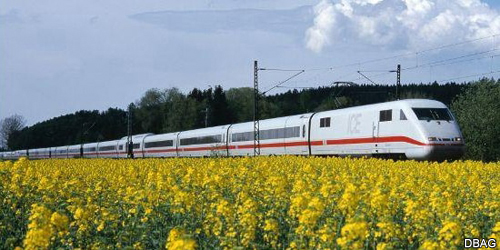
In its initial form, the train comprised up to 14 coaches sandwiched between two power cars, the ICE1. Still in service, this model has been adapted to run, among other routes, daily services from Hamburg to in Switzerland, requiring additional pantographs, power supply and signalling equipment. The version that is adapted to Swiss service is currently available as a HO Scale model in DC and DCC-Sound versions.
An ICE1 Train departs Interlaken West for Interlaken East in Switzerland.
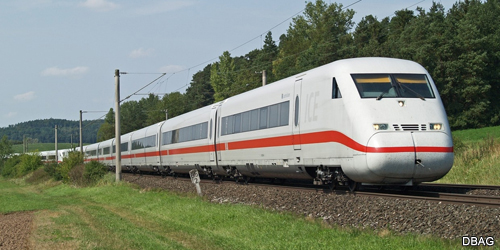
ICE2 broke away from the sandwich concept to resemble many German and Swiss push-pull units by having a power unit at one end with a DVT with passenger accommodation at the other.
ICE1 and ICE2 were built to a loading gauge beyond UIC so were restricted in their operations. Subsequent versions have 'shrunk' to within UIC gauge and are thus more versatile. They will never be seen in Britain outside of our HS1 and proposed HS2 lines as our loading gauge is even smaller!
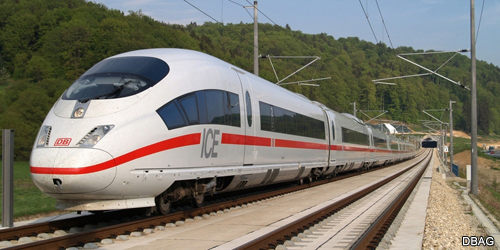
ICE3 changed the design completely by having no power unit with passenger-accommodating DVTs at each end; all of the equipment from the power car is distributed under the floor of each coach. This style was produced in two variants: Class 403 for domestic use and Class 406 (ICE 3M) for Multi-system use. This series constitutes what is now commonly referred to as the 'Velaro'.
Other developments have considered the ICE T, a tilting variation, and the ICE TD, a diesel powered version. The latter had a top speed of 200km/h and their use is restricted by the tax payable on the fuel!
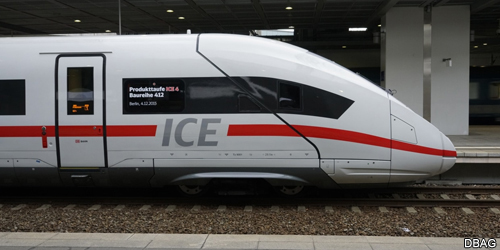
ICE4 is currently in development as Class 412.
Can I regularly see the ICE in England? Short answer, yes! Against their better judgement, Eurostar have dropped their original TGV style of train (e300) in favour of, what is essentially, a Velaro unit (e320). However, since their introduction in 2015, I have noted the comments in various railway magazines concerning the poorer ride quality compared to the older sets. The ICE also completed a test run of the Channel Tunnel on 19th October 2010, arriving at St Pancras in London.
Modelling ICE Trains

ICE Trains are currently available in N, TT, and HO scales, from a number of manufacturers including Fleischmann, Roco, Marklin, Trix, Piko, and in the Marklin MyWorld range.
|
We are always looking to make improvements to our website to try and improve the quality of your visit. We would welcome your feedback and suggestions, so please do not hesitate to e-mail our webmaster with your comments. Alternatively call us on 01903 884488.
Home Cookies Privacy Statement Terms & Conditions Site Map Site Guide
WEEE Regulations Glossary Careers & Jobs
Tel – +44 (0) 1903 884488 Fax – +44 (0) 1903 884377 E-Mail us – click here
Gaugemaster.com is a trading name of Gaugemaster Controls Ltd.
Registered in England No. 2714470, Registered office:
Gaugemaster House, Ford Road
Arundel, West Sussex, BN18 0BN, United Kingdom
VAT Reg. No. 587 8089 71
Copyright © 2003-2014 Gaugemaster Controls Ltd. All Rights Reserved.
















